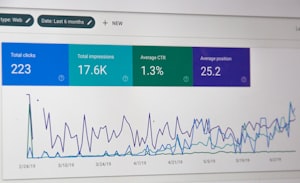“The price of light is less than the cost of darkness.”
Arthur C. Nielsen, Market Researcher & Founder of ACNielsen
How companies collect, curate and use customer data will be a key factor in determining the winning brands of the next decade. The world’s trillion-dollar companies are data-driven corporations harnessing the true potential of the information age . All these companies have one thing in common: they are able to effectively collect, categorize and then analyse large pools of data to understand trends that would otherwise slip through the cracks.
Let's get to the big question on your mind: How can my company leverage the power of video analytics?
When a user clicks the play button on a piece of video content, there is a lot of information waiting to be uncovered. An analysis of user interaction with your video content can not only help you streamline and optimize your existing content to maximize user watch-time, but also create new content that can help you hit the ground running from the get go.
Here are some of the major parameters that can help you make more sense of your video analytics:
1. Video Impressions:
The number of times your video has been clicked or loaded in users browser from the links or embed locations of different websites. Impression is directly related to people being interested in your content. If a video with the exciting or relevant thumbnail is there, customers are more likely to open the video. So to achieve this, the thumbnail should be precisely be selected.
The most basic statistic with respect to videos is the number of impressions. Simply put, the number of times your video was loaded in a user's browser, whether via links, embed locations or the original video location, refers to the impressions generated by that video.
Maximizing impressions is not a straightforward task, but is directly dependent on the number of people your video can reach. This involves SEO for your web page (where the video is originally hosted), sharing this video across different distribution channels as dictated by your target audience, and creating quality content which can attract external links or embeds on other blogs or websites.
2. Number of Views:
While Impressions counts the number of times the video is fetched and loaded for the user, direct views keep track of the number of users who chose to actually hit the play button on your video content. However, view counting can be repetitive, meaning the same user watching your video for the second time is counted twice.
Maximizing direct views is a function of creating an intriguing title, as well as an aesthetically appealing thumbnail for your video. By getting these two factors right, you can ensure that a majority of the users who come across your video are interested enough to start watching the video.
Advanced analytics services, including StoryXpress, can dive deeper into breaking down user viewing analytics. For instance, creators can now know the exact point at which a user left the video, and analyze patterns to further optimize their videos for maximized user retention time.
3. Audience Engagement:
In simple terms, engagement refers to measuring two major things.
a. the ratio of users who interacted with the video the the form of a like, a share, a comment, or any combination of the three,
b. the ratio of users who responded to a particular Call-To-Action accompanying the video. CTAs may include clicks on a link, email submissions, and so on.
Video engagement is directly proportional to the value your content provides to your target audience. A well-produced, informative video not only elicits a like, share or comment, but also increases the user's propensity to share valuable personal information, like an email address.
4. Successful Conversions:
The number of users who reached out to you for more information after viewing your video content, and the few who were subsequently closed to customers are measured by the successful conversions metric. This is by far the most useful measurement when it comes to assessing the effectiveness of your video content in achieving direct business development goals.
Customers reaching out for more information also ties in to #3, as only good engagement will propel customers in inquiring forward about your product or service.
5. Location & Device Type:
Geo location and device type can be extremely important in understanding not only who your audience are, but also the situations in which they watch and interact with your content. This can help you in further optimizing to reach out your target groups in the most potent and cost-effective manner.
In addition, tracking referrals can help you gauge the efficacy of your various distribution channels. In the long-term, this will help you eliminate inefficient or ill-suited distribution mechanisms (for instance, LinkedIn might not be the place to share fashion apparel videos) and double down on those that drive the maximum results.
Video analytics can unlock an understanding of user behavior that is immensely powerful and can help you create content that is leveraged to take advantage of market trends, user habits, and even the different channels through which people access it.
To understand how to create content that spreads, do have a look at this TEDYouth Talk by Kevin Allocca, Youtube's Head of Culture & Trends. Let's hear it from the man himself! Why Videos Go Viral, by Kevin Allocca at TEDYouth 2011.
Insightful! Ain't it?
Video Analytics becomes even more important with the rise of video trends like live videos and podcasts. Just like the other marketing platforms video marketing has also become more of analytics and less of mass-publishing.
Want to discuss video analytics with us? Just drop us a message and we will get in touch.


 Free Screen Recorder for Chrome
Free Screen Recorder for Chrome












